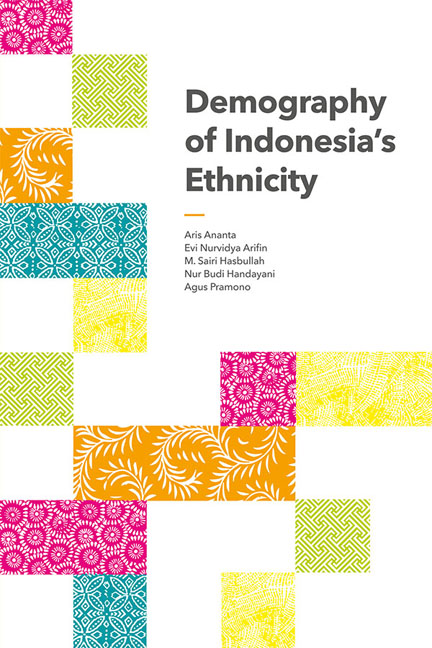Book contents
- Frontmatter
- Contents
- List of Tables
- List of Figures
- Foreword
- Acknowledgements
- 1 CHANGING INDONESIA: An Introduction
- 2 COMPLEXITY OF STATISTICS ON ETHNICITY: Concept, Data and Method of Analysis
- 3 THE NEW CLASSIFICATION: Uncovering Diversity
- 4 ETHNIC DIVERSITY: New Demographic Evidence
- 5 THE FIFTEEN LARGEST ETHNIC GROUPS: Age-Sex Structure and Geographical Distribution
- 6 CHANGE IN SIZE AND COMPOSITION OF ETHNIC GROUPS: Indonesia, 2000–2010
- 7 RELIGION AND LANGUAGE: Two Important Ethnic Markers
- References
- Appendix 1
- Appendix 2
- Index
- About the Authors
3 - THE NEW CLASSIFICATION: Uncovering Diversity
Published online by Cambridge University Press: 10 October 2017
- Frontmatter
- Contents
- List of Tables
- List of Figures
- Foreword
- Acknowledgements
- 1 CHANGING INDONESIA: An Introduction
- 2 COMPLEXITY OF STATISTICS ON ETHNICITY: Concept, Data and Method of Analysis
- 3 THE NEW CLASSIFICATION: Uncovering Diversity
- 4 ETHNIC DIVERSITY: New Demographic Evidence
- 5 THE FIFTEEN LARGEST ETHNIC GROUPS: Age-Sex Structure and Geographical Distribution
- 6 CHANGE IN SIZE AND COMPOSITION OF ETHNIC GROUPS: Indonesia, 2000–2010
- 7 RELIGION AND LANGUAGE: Two Important Ethnic Markers
- References
- Appendix 1
- Appendix 2
- Index
- About the Authors
Summary
Creating a new classification system for ethnic groups in Indonesia is not an easy task. The long list of ethnic categories, with its problems and issues as discussed in Chapter 2, coupled with limited or a complete absence of references (no published literature or local expertise) as well as certain political and social sensitivities, requires a thorough examination of each ethnic category. This is a time-consuming search. The published references used include Melalatoa (1995), Hidayah (1996), Koentjaraningrat (1994), Riwut (1958) and Riwut and Mantikei (2003).
Our New Classification is not an attempt to make a list of official ethnic groups. As discussed in Chapter 2, the peoples of Indonesia are free to determine their own ethnic groups. They may even change their ethnic groups as frequently as they wish, as the change does not have any consequences. This is different from some other countries such as China, whose government officially recognizes fifty-six ethnic groups, and Singapore, who categorizes its population into four major groups.
Therefore, the New Classification is not supposed to be fixed for a long time. Rather, the New Classification should be continuously improved as new data and references are available. Yet, this is the first comprehensive classification of ethnic groups based on the 2010 population census.
This chapter sets out the New Classification of ethnic groups based on the 2010 population census for Indonesia. It is new because our classification is different from the Initial Classification discussed in Chapter 2. To some extent it is also significantly different from the one resulting from the 2000 population census, although it has some similarities with that of 2000. This chapter discusses the significance of the New Classification and examines what new groups are revealed from the New Classification. To provide a better understanding of the New Classification, this chapter also presents three comparative case studies on ethnic composition based on the New and Initial Classifications at the provincial level. The selected case studies are on the provinces of Aceh, West Sulawesi and East Nusa Tenggara.
SIGNIFICANCE OF THE NEW CLASSIFICATION
The New Classification of ethnic groups is expected to capture the rich diversity of the ethnic composition of Indonesia as a whole and its provinces, particularly amongst those with many small ethnic groups in the eastern provinces of Indonesia.
- Type
- Chapter
- Information
- Demography of Indonesia's Ethnicity , pp. 39 - 67Publisher: ISEAS–Yusof Ishak InstitutePrint publication year: 2014



